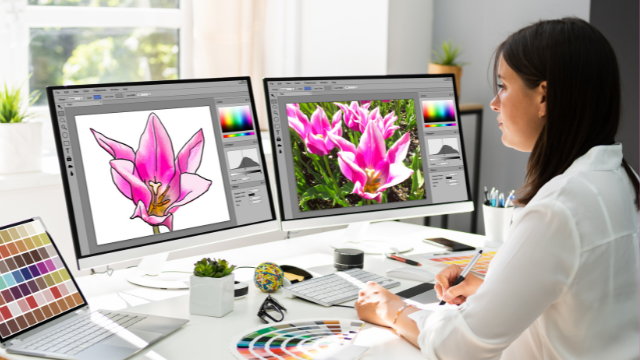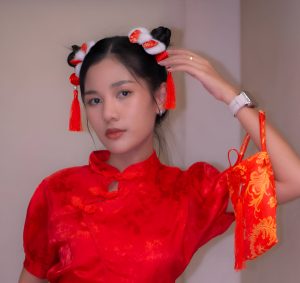Are you ready to embark on a thrilling journey into the world of graphic design? As a graphic designer, you’ll unleash your creativity and technical skills to communicate information through captivating designs. From posters that catch the eye to logos that leave a lasting impact, you have the power to evoke emotions and captivate your target audience. In this article, we’ll explore the role and responsibilities of a graphic designer, delve into industry trends, and provide valuable job search tips. Let’s dive in!
Graphic Designers’ Responsibilities
As a graphic designer, you will be responsible for creating visual concepts using graphics, images, and art, and utilizing design software to develop various layouts, logos, packaging, and other design materials. Your role as a graphic designer is to bring ideas to life through creative and visually appealing designs. You will work on a range of projects, including posters, brochures, websites, and marketing materials, using elements like shapes, colors, typography, and images to communicate information effectively.
One of the main responsibilities of a graphic designer is to study design briefs and understand the requirements of each project. You will need to collaborate with clients and other professionals to ensure that the designs meet their expectations and effectively engage the target audience. It’s important to advise clients on strategies to enhance the visual appeal and effectiveness of the designs.
As a graphic designer, you will be expected to create designs using design software, carefully selecting colors, images, typography, and other design elements to achieve the desired visual impact. You will also need to produce drafts for client review and be open to making revisions based on their feedback.
To excel in this field, it’s crucial to stay up-to-date with the latest design trends and tools. By continuously honing your skills and expanding your knowledge, you will be able to create innovative and impactful designs that stand out in the industry.
Required Skills and Qualifications
To become a successful graphic designer, you need a combination of technical skills and creative abilities. Here are the required skills and qualifications for the job:
- Proficiency in design software: Graphic designers must be skilled in using design software such as Adobe Creative Suite, including Photoshop, Illustrator, and InDesign. These tools are essential for creating and editing visual concepts.
- Strong artistic and creative skills: Graphic designers need a natural eye for design, color, and composition. They must be able to think creatively and come up with innovative solutions to design problems.
- Attention to detail: Graphic designers must have a keen attention to detail to ensure that their designs are accurate and free of errors. They need to pay close attention to typography, spacing, and alignment.
- Communication and collaboration skills: Graphic designers often work as part of a team and need to effectively communicate their ideas and collaborate with clients and colleagues. Good communication skills are essential for understanding client requirements and delivering designs that meet their needs.
- Time management and organizational skills: Graphic designers often work on multiple projects with tight deadlines. They need strong time management and organizational skills to prioritize tasks, meet deadlines, and ensure that their work is completed efficiently.
Education and Training for Graphic Designers
To become a successful graphic designer, you will need to acquire the necessary education and training. The field of graphic design is constantly evolving, and staying up-to-date with the latest design trends and tools is essential. A formal education in graphic design or communication design is highly recommended. Many universities and colleges offer bachelor’s degree programs in these fields, which provide a comprehensive understanding of design principles, software skills, and industry practices. Additionally, online certificate courses are available for skill enhancement and specialization. These courses allow you to learn at your own pace and provide a flexible option for working professionals. Acquiring education and training in graphic design will not only equip you with the technical skills needed to create visually appealing designs but will also provide you with a deeper understanding of what it means to be a graphic designer. It will help you develop a critical eye for design, understand the principles of color theory, typography, and layout, and learn how to effectively communicate with clients and other professionals. With the right education and training, you will be well-prepared to embark on a successful career in graphic design.
| Pros of Formal Education in Graphic Design | Cons of Formal Education in Graphic Design |
|---|---|
| Provides comprehensive understanding of design principles | Can be expensive and time-consuming |
| Offers structured curriculum and guidance | May not provide hands-on experience |
| Provides opportunities for networking and collaboration | May not cover the latest design trends and technologies |
| Offers access to experienced instructors and industry professionals | May require relocation or commuting to campus |
| Can enhance job prospects and credibility | May not be necessary for all graphic design positions |
Incorporating a table into the section evokes an emotional response by presenting a clear and concise comparison of the pros and cons of formal education in graphic design. This helps the audience make informed decisions about their education and training options.
Career Opportunities for Graphic Designers
Now let’s explore the various career opportunities available to graphic designers. As a graphic designer, you have a wide range of options to choose from. Here are five exciting career paths you can pursue:
- Brand Identity Developer: As a brand identity developer, you will specialize in creating unique and memorable visual identities for companies. You will work on designing logos, color schemes, typography, and other brand elements that represent the essence of a business.
- Package Designer: If you have a passion for product design and packaging, this is the perfect career path for you. As a package designer, you will create visually appealing and functional packaging for various products, ensuring they stand out on the shelves and attract customers.
- Art Director: As an art director, you will oversee the visual aspects of projects, managing a team of designers and ensuring that the final product meets the client’s vision. You will have the opportunity to lead creative teams and shape the overall aesthetic of a project.
- Web Designer: With the increasing importance of online presence, web designers are in high demand. As a web designer, you will create visually appealing and user-friendly websites, ensuring a seamless user experience through thoughtful design and layout.
- Advertising Creative: As an advertising creative, you will work closely with copywriters and other creative professionals to develop visually compelling advertisements for print and digital platforms. Your designs will play a crucial role in capturing the attention of the target audience and conveying the right message.
These are just a few of the many career opportunities available to graphic designers. Whether you choose to work in-house, at agencies, or as a freelancer, the field of graphic design offers endless possibilities for creativity and professional growth.
The Future of Graphic Design
As a graphic designer, you can look forward to an exciting future in the field, where advancements in technology and evolving design trends will continue to shape and redefine the industry. The future of graphic design holds immense potential for creativity and innovation. With the rapid development of artificial intelligence (AI), designers can expect automation of repetitive tasks and personalized designs for each user. AI-powered tools like Canvas Magic Resize generate designs in multiple sizes, saving designers time and effort. Immersive designs incorporating motion graphics, 3D animation, and virtual reality (VR) will provide users with a memorable and interactive experience. Bold typography will continue to be a prominent design trend, capturing users’ attention and helping brands stand out in a crowded marketplace. Minimalism, with its focus on simplicity and clean lines, will remain popular, especially in a mobile-first world. Additionally, inclusive design will gain more recognition, ensuring accessibility for all users and promoting diversity and inclusivity in the design industry. Embrace these upcoming trends and technologies to stay ahead in the ever-evolving world of graphic design.
| Future of Graphic Design |
| :— | :— | :— |
| AI in Graphic Design | Immersive Designs | Bold Typography |
| – AI automates repetitive tasks in the design process. | – Designers focus on creating immersive designs. | – Typography becomes bolder and more expressive. |
| – AI personalizes designs for each user. | – Motion graphics, 3D animation, and VR are incorporated into designs. | – Designers experiment with combining different fonts and styles. |
| – AI saves designers time and effort. | – Scrolling story format allows users to scroll through a story or experience. | – Typography is used as the primary visual element in designs. |
Key Differences Between Graphic Design and UX/UI Design
How does graphic design differ from UX/UI design? Here are the key differences between the two:
- Focus: Graphic design primarily focuses on visual designs for print, web, or multimedia, while UX/UI design focuses on the overall user experience of a product.
- Elements: Graphic design uses design elements like shapes, colors, typography, and images to evoke emotions and feelings, whereas UX/UI design focuses on the visual elements that users interact with to enhance usability and functionality.
- Areas of Focus: Graphic design is more concerned with aesthetics and storytelling, while UX/UI design is concerned with usability, interaction design, and user research.
- Collaboration: Graphic designers often work independently or in small teams, while UX/UI designers collaborate closely with cross-functional teams including researchers, developers, and product managers.
- Goals: The goal of graphic design is to create visually appealing and engaging designs that communicate a message or brand, while the goal of UX/UI design is to create intuitive and user-centered designs that provide a seamless and enjoyable user experience.
Understanding these key differences is crucial in determining which field aligns better with your interests and skills. While graphic design focuses on creating visually stunning designs, UX/UI design prioritizes user satisfaction and usability. Both fields offer exciting career opportunities, so choose the path that best suits your passion and goals.
Industries and Companies Hiring Graphic Designers
If you’re a graphic designer looking for job opportunities, there are various industries and companies that are actively hiring for your skills and expertise. Graphic designers play a crucial role in creating visual concepts and communicating information through design. They can work in a variety of industries, including internet and software development companies, television and video production companies, marketing and advertising agencies, publishing and media companies, and retail and e-commerce companies.
Internet and software development companies often hire graphic designers to create visually appealing websites and user interfaces. Television and video production companies require graphic designers to design graphics and animations for television shows, films, and commercials. Marketing and advertising agencies need graphic designers to create eye-catching advertisements for print and digital platforms. Publishing and media companies hire graphic designers to design book covers, magazine layouts, and marketing materials. Retail and e-commerce companies rely on graphic designers to create compelling product packaging, logos, and branding materials.
With the increasing demand for graphic designers in various industries, there are ample opportunities for you to showcase your creativity and expertise. Explore job boards, network with professionals, and stay updated on industry trends to find the perfect job in the field of graphic design.
Specializations and Professional Certification
Graphic designers can specialize in various areas of design and obtain professional certifications to enhance their expertise and job prospects. Specializations allow graphic designers to focus on specific areas of design that align with their interests and talents. Here are the top five specializations in graphic design:
- Corporate branding: Enhancing or maintaining company brands across various sectors.
- Manufacturing: Developing product packaging that attracts potential customers.
- Advertising: Creating visually appealing advertisements for print and digital platforms.
- Common roles for Graphic Designers: Creative Director, Art Director, Art Production Manager, Package Designer, Brand Identity Developer.
- Professional certification can enhance job prospects for Graphic Designers.
By specializing in a particular area, graphic designers can deepen their knowledge and skills in that specific field, making them more valuable to employers. Additionally, obtaining professional certification demonstrates a commitment to professional growth and can give graphic designers a competitive edge in the job market.
With a specialization and professional certification, graphic designers can showcase their expertise in a specific area of design, making them more marketable to potential employers. It allows them to stand out from the competition and increases their chances of landing their desired job. So, if you’re a graphic designer looking to enhance your career prospects, consider specializing in a specific area and obtaining professional certification to elevate your skills and open up new opportunities.
Crafting an Effective Job Description for Graphic Designers
When crafting an effective job description for graphic designers, it is important to clearly outline the key responsibilities and qualifications required for the role. A graphic designer is responsible for creating visual concepts using graphics, images, and art. They use design software to develop layouts, logos, packaging, and other graphic design work. As a graphic designer, you will collaborate with clients and other professionals to create successful designs that effectively communicate information. You will study design briefs, determine requirements, and advise clients on strategies to engage their target audiences. Your role will involve creating designs using software and selecting colors, images, typography, and other design elements. Additionally, you will produce drafts for client review and make revisions based on feedback. It is crucial for a graphic designer to stay up-to-date with the latest design trends and tools. By crafting a clear and concise job description, you can attract candidates with the right skills and qualifications to excel in this role.
Tips for Job Searching in Graphic Design
To maximize your chances of finding the perfect graphic design job, utilize various job search platforms and network with professionals in the industry. Here are some tips to help you in your job search:
- Explore job search platforms: Utilize popular job search platforms like Workable, Indeed, LinkedIn, and Behance to find relevant job opportunities in graphic design. These platforms allow you to filter your search based on location, experience level, and job type, making it easier to find the right fit for you.
- Customize your application materials: Tailor your resume and cover letter for each application to showcase your skills and experience that align with the specific job requirements. Highlight your design portfolio and any relevant projects you have worked on.
- Network with professionals: Attend industry events, join online design communities, and connect with professionals in the graphic design field. Networking can help you learn about job openings that may not be advertised publicly and can also provide valuable insights and advice from experienced designers.
- Stay updated on industry trends: Keep yourself informed about the latest design trends, tools, and techniques. This will not only help you stay competitive in the job market but also demonstrate your passion and commitment to the field.
- Seek internships or freelance opportunities: Consider gaining practical experience through internships or freelance projects. These opportunities can not only help you build your portfolio but also provide valuable industry connections and references.
Role and Responsibilities of a Graphic Designer
As a graphic designer, your role is to create visually captivating designs that effectively communicate information and engage audiences. You are responsible for working on a variety of projects such as posters, packaging, logos, and marketing materials. Using elements like shapes, colors, typography, and images, you craft designs that capture attention and convey the desired message.
To give you a better understanding of the role and responsibilities of a graphic designer, here is a table highlighting some key aspects:
| Role and Responsibilities of a Graphic Designer |
|---|
| – Study design briefs and determine requirements |
| – Advise clients on strategies to engage target audiences |
| – Create designs using software and select colors, images, typography, etc. |
| – Produce drafts for client review and make revisions based on feedback |
| – Keep up-to-date with the latest design trends and tools |
In addition to these responsibilities, graphic designers can work in-house, at agencies, or as freelancers. They often collaborate with clients and other professionals to ensure the success of their designs.
Graphic design plays a crucial role in various industries, including internet and software development companies, television and video production companies, marketing and advertising agencies, publishing and media companies, and retail and e-commerce companies.
The Impact of AI and Emerging Trends in Graphic Design
Graphic designers today are experiencing the impact of AI and are witnessing emerging trends that are shaping the future of graphic design. Here are some of the key trends and the impact of AI on graphic design:
- AI automation: AI is automating repetitive tasks in the design process, saving designers time and effort. Tools like Canvas Magic Resize generate designs in multiple sizes, making it easier to create responsive and accessible designs.
- Immersive designs: Designers are focusing on creating immersive designs that engage users and provide a memorable experience. Motion graphics, 3D animation, and virtual reality (VR) are being incorporated into designs to create interactive and captivating visuals.
- Bold typography: Typography is becoming bolder and more expressive, with brands and businesses using it to stand out. Designers are experimenting with combining different fonts and styles to create unique and attention-grabbing designs.
- Minimalism: Minimalism remains popular in graphic design, with a focus on simplicity, clean lines, and negative space. Minimalist designs are easy to read and understand, particularly in a mobile-first world, and they create visually appealing and clutter-free designs.
- Inclusive design: Designers and businesses are recognizing the importance of designing for all users. Inclusive design ensures accessibility for everyone, considering users with disabilities, cultural backgrounds, and languages. This trend promotes diversity and inclusivity in the design industry.
These emerging trends, coupled with the impact of AI, are transforming the way graphic designers work and shaping the future of the industry. As a graphic designer, it is important to stay updated on these trends and embrace new technologies to stay ahead in the field.




